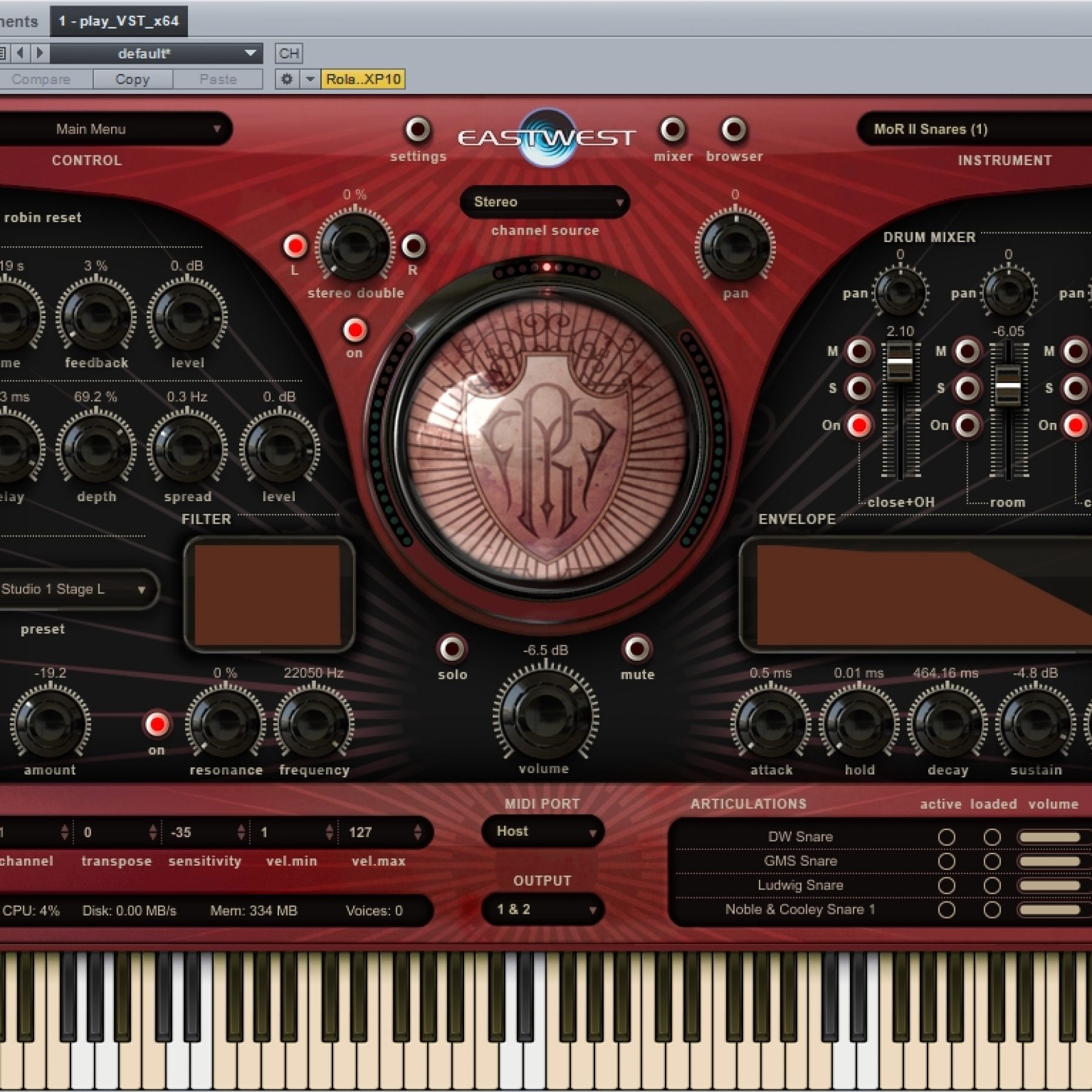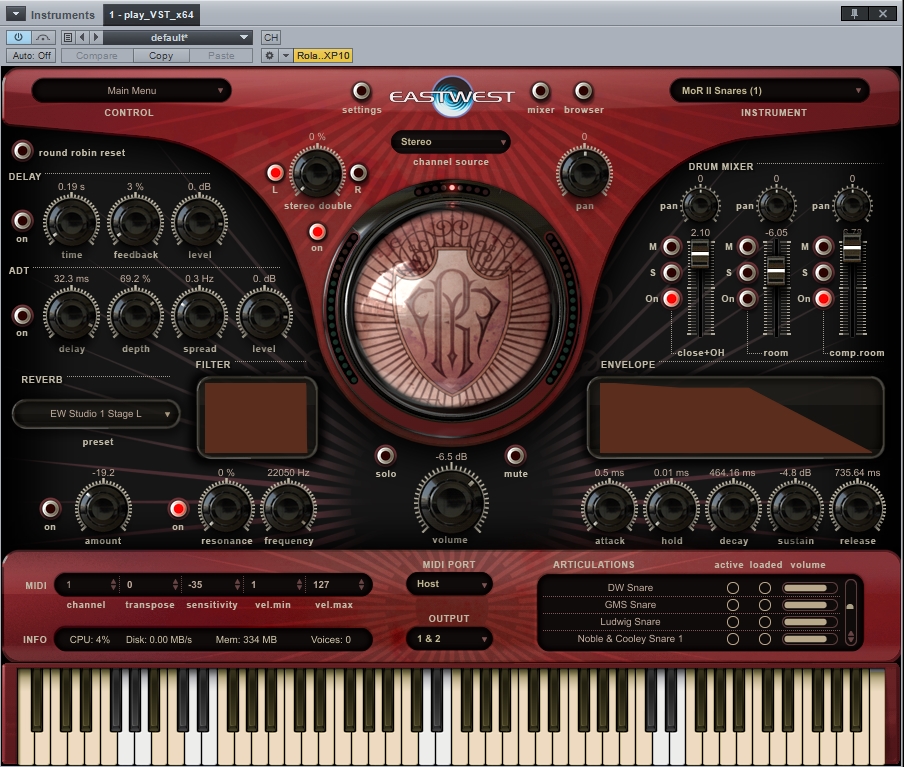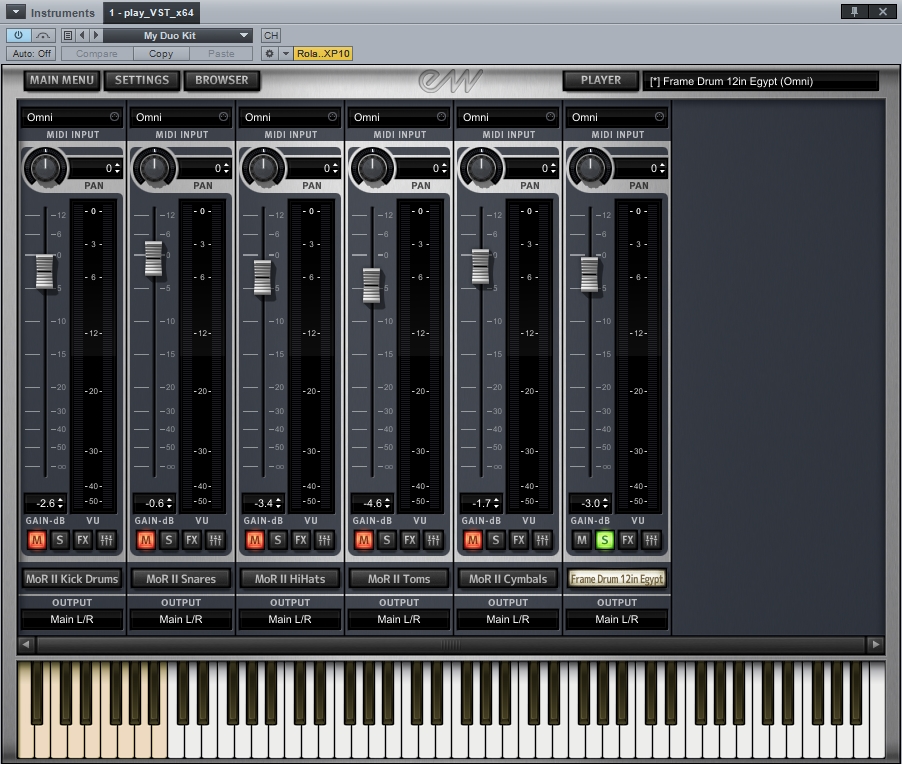
Review: Eastwest Ministry of Rock and Storm Drum 3

I’ve been programming drums for years, forever searching for the holy grail of realism and authentic sound that will allow me to create convincing drum tracks whenever working with a real drummer isn’t possible. So it was exciting stuff hearing of EastWest’s Storm Drum 3, featuring the legendary Mickey Hart of Grateful Dead fame. After a bit of research I realised SD3 is purely a percussion instrument and doesn’t include what you’d call a traditional drum kit. For that, I needed EastWest’s Ministry of Rock II virtual instrument, which has been around awhile. EastWest came to the party and gave me both SD3 and MORII to review, so heads-up – we’re actually looking at two products here in pursuit of the perfect percussion plug-in.
All EastWest instruments are hosted in its own shell program called Play4 (think Kontakt Player here) and it’s recommended with any EastWest virtual instrument that you download the latest Play4 software first, install it and then continue the sample library load of your chosen instrument through the custom installation option. Not quite the usual “just go ahead and install it” system we’re used to, but EastWest provides a heap of FAQ and How-To info on the website. So if you’re one of those users who always begin installations by flipping the ReadMe file into the trash, think again.
The first thing you might need to do, like me, is buy a new hard drive to store the near 140GB of samples that make up SD3 and MORII provided across 19 dual-layer DVDs. For the record, I bought a 3TB external USB 3.0 drive and it works flawlessly streaming the samples in real time, rather than loading them into RAM.
Ministry of Rock II – Rock and Roll Drumming
To quote EastWest, “the entire MORII library was put together with one goal in mind: to create a virtual instrument capable of producing sounds that could actually produce a hit record or film score without any live drum, bass, or guitar overdubs”. Bass or guitar? That’s right, MORII also has bass and electric guitar samples and we’ll look at these separately.
Snares Galore
Three drum kits in various configurations are included in full or Lite load-outs, a DW, Gretch and Ludwig kits. There are six extra snares with a Brady, Tempus, Noble and Cooley 1, Noble and Cooley 2, Sonor and GMS types, and you get a choice of Instanbul, Sabian or Zildjan cymbals. Everything can be swapped in and out, so the possible combinations provide an extensive palette of drum sounds. The actual samples are superb with a wide range variation of how the drum is struck – snare hits are loaded with centre, edge and rimshot samples, as are the high hats samples with top and edge hits included. As an illustration, if you choose to rack up a different snare more than a thousand files are quickly exchanged.
The drum kits are separated into five subgroups of Kick, Snare, Hats, Cymbals and Toms. This allows you to tweak settings for microphone levels, effects, reverb, panning and volume for each the five subgroups individually – and yes, we’ve just gone beyond that authenticity I was after, because in the real world you simply couldn’t have the cymbals in the overhead mics and not the toms, snare and so on. It’s a common cheat in drum samplers and I’m not complaining, since it introduces a lot more versatility in the drum sounds. The three microphone mix settings are Close/OH, Room, and Room with Compression. The latter two can’t be simultaneously on, it’s one or the other. EastWest refers to the Room/Comp level as a “magic” slider and it’s true, bringing all the kits impressively to life. However, I found many of the presets were too saturated with this setting and needed pulling back. The effect was created during the recording of the kits by using a blend of the close microphones, some different room mics (rather than those used on the Room effect) and processing these through a Fairchild compressor and a Manley Massive Passive EQ – with that kind of outboard, now you know why it works well.
EastWest calls the various drum setups “Articulations” and it’s possible to have more than one loaded at the same time. You can have multiple kick drums active, if you like. I found this feature best used (as I expect it’s designed) for quickly comparing different kit components before unloading the pieces you discard. Once you’ve settled on your final kit configuration you can apply effects like ADHSR, a doubler parameter (apparently pioneered by The Beatles), delay and a filter. These are pretty much fine-tuning options that can let you build an exacting sound or you can get radical to create off-the-wall drum kits.
The sounds of the kits are excellent, although as always with virtual instruments like this you’ll no doubt find drums that you’ll never like or use. For an added dose of reality MORII has a neat trick up its sleeve called Repetitions. Embedded inside some of the sample types (snares and kicks, for example) are alternative sound files that are automatically triggered when MORII senses you’re playing very fast repetitions such as a rapid snare fill, avoiding the dreaded machine gun effect that can happen. It’s clever and works well.
A few things in MORII were disappointing. While it uses pretty much an accepted key mapping for all drum samplers beyond General Midi, I discovered some slight differences that prevented me using my programming with other drumming software. Usually, you can tweak the midi assignments accordingly, but I couldn’t find a way of doing this in MORII. Also, the GUI doesn’t display exactly what kind of sample you’re playing. I realise you’re supposed to hear that, but it’s not always so clear. Is that the centre of the snare or the edge? The bell of the ride or the crash cymbal? The only way to know for sure is referring to the PDF manual list as you go. Eventually, I suppose you’ll remember what’s mapped where.

Guitars and Basses
MORII also has a huge library of bass and electric guitar samples. The latter is biased towards heavier, metal and rock sounds although there is a Fender Telecaster and Jaguar. You get single notes that can be combined for chords, strumming patterns, palm-mutes, squeaks, clicks and pick sounds… the whole gamut. All of the samples are well-produced, authentic and are certainly a far cry from the tortured noises that many virtual instruments emit in attempts to emulate electric guitars. The problem is that the learning curve required to program realistic guitar playing is almost as steep as teaching yourself the real thing. The heavy guitars in MORII come into their own best for creating power chords, huge progressive-rock walls of sound or, in the least, chunky and distorted rhythms. Just jam down a key and let the grunge flow. With a little more finesse the telecaster sounds will make passable country licks and other clean melodies. Basically, if you have a lot of programming patience you can theoretically, eventually achieve anything, because the sounds are all there. But you soon hit a threshold where finding a real guitarist will be easier.
The bass sounds, on the other hand, are spot-on and even grumpy old bass players like myself will be tempted to leave the trusty Fender in the case and use the bass sounds provided in MORII, particularly if you don’t have a five-string. You get a Stingray five-string along with a good range of other basses like Fender, Hofner and Rickenbacker with both fingered and picked playing. The different samples are really usable and convincing, and the only thing missing is an upright bass – but this is the Ministry of Rock right? Nobody seriously plays an upright bass for rock music.
It’s worth noting that all of the effects available for the drumming patches work with the guitar and bass sounds too, so you can tweak them into cool alternative noises using the filters and reverbs.
Talking of cool noises, this brings us to where we should have started – the Storm Drum 3 virtual instrument and Mickey Hart’s percussion Nirvana.

Storm Drum 3 – What the Heck is That Noise?
Remember that SD3 is a completely different instrument that opens inside the same Play4 shell, so launching it produces a new GUI, although some aspects like the mixer remain the same. The best way to describe SD3 is inspirational – but not quite how you might expect.
It’s a percussion virtual instrument filled with hundreds of familiar, unknown, esoteric and downright baffling drums, gongs, cymbals and all manner of noise-making… well, things. Each one is played in a wide variety of techniques from the softest brush of the fingers to flat-out whacking with a cricket stump in each hand. If you require any kind of percussion sound at all, Storm Drum 3 will have it.
But what exactly do you need?
That’s the problem. Unless you’re some sort of an expert on percussion (like Mickey) a lot of the instrument names will mean little to you. The browser helps by sorting them into categories of Big Drums, Small Drums, Metals (bells, cymbals, etc), Shakers, Woods, Taiko Family, Live Loops (by Hart) and “Gongs, Clocks and Waterphones” – this final one pretty much says it all. Inside these categories a whole universe of World Music percussion opens up and there’s only one thing you can do – start hitting things and find out what they sound like.
This is where the inspirational side of SD3 is so prominent. You constantly discover sounds that capture your imagination, letting you consider all kinds of wonderful possibilities. Almost all the instruments have single hits of every type, plus rolls and flams played by Hart. That’s aside from the length and tempo-synced samples in the Live Loop category.
It’s the opposite side of the coin that is hard to imagine – that someone will ever think, “Hmm, I reckon the start of the second chorus needs tuned Englehart bells hit with a stick…” and they go straight into SD3 to find it. Unless, as I said before, you’re the full bottle on world percussion you can expect a long period of exploration and innovation with SD3 before you’re familiar enough to have go-to sounds. Don’t worry, it’ll be a fun journey.
You’d also think it unlikely that with all these sounds at your fingertips some kind of extra processing is needed – still, it’s there. Storm Drum 3 offers similar effects to MORII packaged in the different GUI. You get AHDSR, reverb and delay, tuning, resonance, stereo spread, panning and a filter. That should keep you busy for a while, if you reckon some of the more weird samples aren’t weird enough.
The only hiccup I encountered with SD3 was a problem loading EastWest’s new SSL/EW FX suite – an SSL console emulation – which is included free in SD3 (and probably all other upcoming, new instruments) or it’s an optional extra costing US$99.00 for owners of older EastWest instruments such as MORII. We’re currently chasing this one down, but I suspect the installation was confused by my installing MORII first, before SD3. I’ll keep you posted on this one – watch for comments.
Summary:
Ministry of Rock II is listed on EastWest’s site at US$299 for the DVD version and Storm Drum 3 is $395 ($495 for hard-drive included versions)… a total of $695 for both which, considering you’re “only” getting drums, percussion, bass and guitar samples is a fair fistful of dollars in any currency. I reckon it’s well worth it. For the money, you get two premium virtual instruments and importantly you’ll never have to buy another drum or percussion sample again. With MORII EastWest has recognised that the primary difference between many drum kits lies in the snare, so providing those extra snares covers a lot more kit styles and sounds beyond the three core kits you’re given. As for Storm Drum 3…well, good luck trying to figure out a sound it can’t deliver. Check out the EastWest website at www.soundsonline.com for pictures and videos about the exhausting recording process of SD3 and I think you’ll agree EastWest and Mickey Hart left no bell, gong, cymbal or drum behind to create such a vast library.
Between Ministry or Rock and Storm Drum 3 you’ll have everything drum-wise covered. What else could you ask?
















RESPONSES